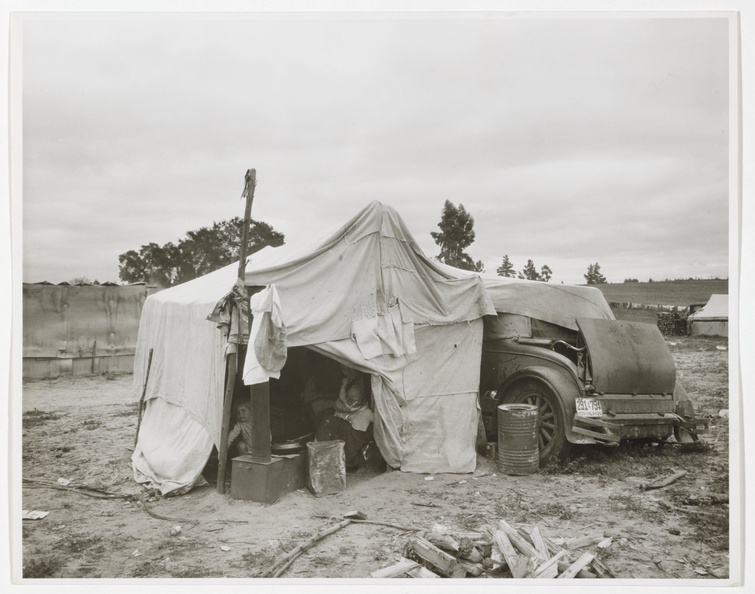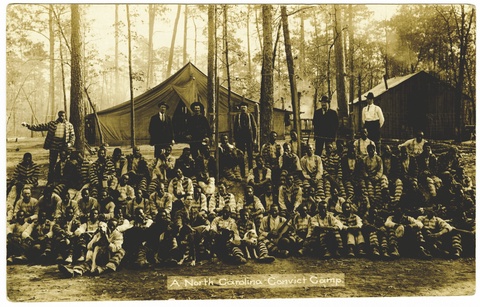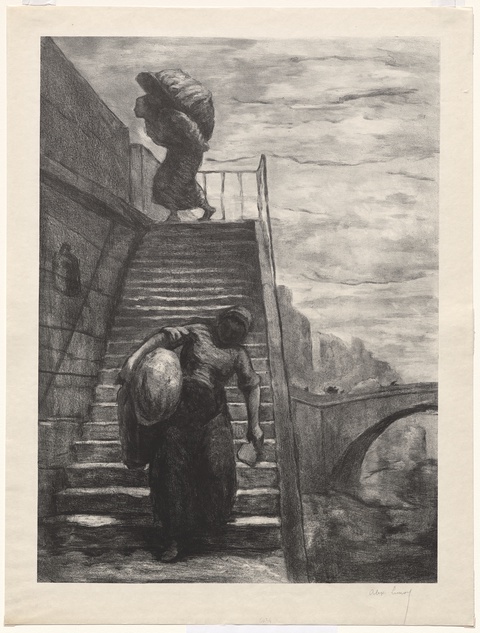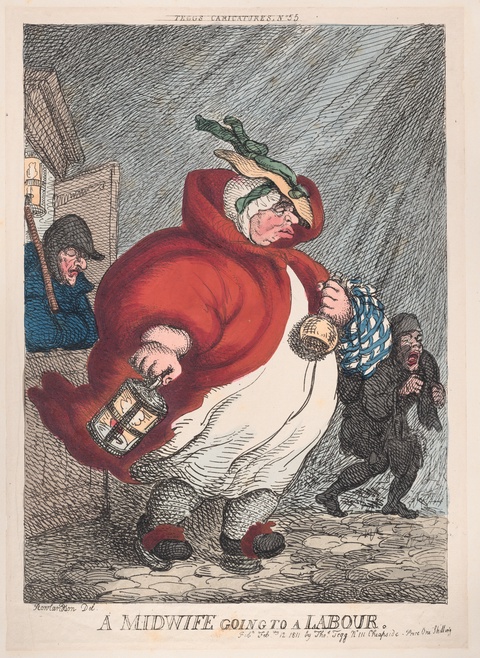Industrial Optics: How We See Labor and Why It Matters
By Blake Palmer•July 2022•8 Minute Read

Dorothea Lange, Cotton Pickers’ Camp, Nipomo California, February 1936. Rijksmuseum. A family of houseless cotton pickers take refuge under a temporary shelter in rural America during the Great Depression.
The emergence of photography and the Realist art movement during the Industrial Revolution resulted in images that deromanticized labor. The way work and the working class are depicted in these artworks and photographs affects our understanding of global labor justice.
Introduction
The Industrial Revolution marked the beginning of significant shifts in culture and technology, including the emergence of photography, that changed the way people from a variety of class and cultural backgrounds viewed labor. Strikes and unions became more common as workers became increasingly aware of the power of collective action to improve their individual lives.
In the 1840s, European artists coalesced around a new movement called Realism.1 They broke with Romantic traditions, which focused on dramatic settings and ideal subjects, often ignoring, backgrounding, or sanitizing portrayals of labor. Instead, Realist artists focused on the menial, difficult, or even exploitative aspects of life and labor that had become the hallmark of industrialization and the colonial system that accompanied it. At the same time, the growing popularity of photography made it possible to document parts of everyday life that had often been downplayed, idealized, or hidden from view. These new images allowed workers to see where their needs intersected and laid a foundation for action and solidarity.
Many of the images that came from this school of thought brought visibility to forced labor, colonization, and women’s work, stripping them of their romantic veneer and exposing their underlying cruelty.
Dorothea Lange, Cotton Pickers’ Camp, Nipomo California, February 1936. Rijksmuseum. A family of houseless cotton pickers take refuge under a temporary shelter in rural America during the Great Depression.
Forced and Enslaved Labor
The early Industrial Revolution increased the demand for raw materials, as well as the cheap labor required to extract them.2 Chattel slavery, especially in colonial settings, provided much of this labor through a legally codified system of buying and selling certain classes of people, who were often forced to work in conditions similar to those endured by nonhuman livestock. Abolitionist movements led to the end of legal chattel slavery throughout the world, but its brutal legacy remains.
Jim Crow
Racialized enslavement was officially abolished in the United States in 1865. Yet, a series of statutes known as the Jim Crow laws recodified many of slavery’s oppressive practices. Jim Crow allowed for the continued exploitation of marginalized people, especially people considered Black, through laws that limited speech, education, and social relations based on race. Though most labor was technically voluntary under this system, seasonal farm workers and sharecroppers—mainly Black folks, migrant laborers, and poor whites—faced financial insecurity and limited mobility, leaving many not much better off than they had been before abolition. Limited options made it necessary for some freed slaves to work as sharecroppers for their former owners—essentialy finding themselves working in the same conditions under a different name.
Despite the body of media aimed at romanticizing race and labor relations in the American South, images like this one by Dorothea Lange—taken three years before the release of the Confederate nostalgia film Gone with the Wind—confronts the unbalanced power dynamics and sense of entitlement typical of privileged whites in the Jim Crow-era United States. Her photograph depicts a white plantation owner in rural Mississippi standing proudly in front of his car and field laborers, flaunting his perceived dominance over the people that he considers his possessions.
Dorothea Lange, Plantation Owner, Mississippi Delta, Near Clarksdale, Mississippi, 1936. The Museum of Fine Arts Houston. Credit: The Target Collection of American Photography, museum purchase funded by Target Stores. A white plantation owner stands proudly in front of his car and Black field workers, showing an attitude of possessive dominance.
Forced Labor Today
Far from being truly abolished, forced labor is still a surprisingly common practice in much of the world. In the United States, the 13th amendment to the constitution, which ended racialized enslavement, still allows for the “slavery” and “involuntary servitude” of convicted prisoners.3 Though not officially racial, overpolicing, oversentencing, and higher bail fees against non-white people and neighborhoods has contributed to a prison system that disproportionately targets people of color. The handwritten text on the back of this 1910 postcard of a North Carolina convict camp illustrates this ongoing disparity: of the 70 prisoners in the photograph, only four are white.
The capitalist demand for cheap labor is also a factor in modern slavery, with common consumer products like shrimp and chocolate making their way to stores through the efforts of enslaved workers. Major corporations like Nestlé have been implicated in human enslavement in the Thai seafood industry and even the enslavement of children in West Africa.4 5 Media coverage of contemporary slavery, including photojournalism and documentary work, has led to boycott threats, interventions by human rights organizations, and the release of enslaved people.
Colonial Labor
The colonization of Madeira, an archipelago off the northwest coast of Africa once populated by thick forests and native wildlife, is considered by some scholars to mark the birth of capitalism. Shortly after its “discovery” in 1419, Portuguese colonizers used imported slave labor to strip the island for timber and converted forest habitats into sugar fields.6 These plantations, and the environmental and human exploitation that characterized them, served as early models for the brutal colonial system. European colonization would go on to destroy countless natural ecosystems, suppress hundreds of indigenous cultures, and force millions into backbreaking, often deadly physical labor.
Anonymous, Plantation owner with contract workers on the Accaribo plantation in Suriname, 1916-1930. Rijksmuseum. A well-dressed white plantation owner with a tobacco pipe stands over a group of dark-skinned contract workers in Suriname, South America.
Despite the violent nature of colonialism, early artistic depictions of plantation conditions usually portrayed serene pastoral landscapes, passive or backgrounded dark-skinned laborers, and benevolent European settlers bearing “The White Man’s Burden.”7 Images like this one, showing a white colonist welcomed into his home at an idyllic estate while colonized workers compliantly perform their tasks, typify depictions of labor from the Romantic era of European art.
The emergence of photography, however, made it possible for less idealized portrayals of colonized labor to emerge, even when the photographer’s intent was not to criticize the colonial project.
Reiner Vinkeles, Reinhart at La Recompense sugar cane plantation, in or before 1971. Rijksmuseum. An idyllic plantation scene shows a white colonist being welcomed into his home while enslaved workers labor passively in the foreground.
Images from colonial plantations and mines in Africa, Latin America, and Southeast Asia gave glimpses of the inhumane conditions that characterized Western imperialism. Photographs like these from colonial-era Suriname and Indonesia were largely produced to promote, support, and justify colonial practices and ideologies. Thanks to shifts in the way colonialism is framed and discussed, these images can now be seen as evidence of the dehumanizing effects of white supremacy, Western domination, and imperial violence.
Women’s Labor
The Industrial Revolution forced important questions about women’s labor. During this period, photographs and Realist portrayals of women at work began to strip away certain romantic notions of womanhood and depict the arduous reality. Yet even as more women entered the workforce, crucial labor such as child care, cooking, cleaning, and sewing were being naturalized as “women’s work.”
What is Women’s Work?
The consequence of characterizing these roles as natural to women was that such labor could be devalued and exploited. Work done inside the home, an expectation made of most women, went unpaid and underappreciated. Women who did find jobs in fields or factories were often limited to feminized tasks, like textile work, harvest gathering, and “domestic” roles, and were paid significantly less than men in similar roles. What’s more, important roles like midwifery, which contributed to women’s medical needs and reproductive freedom, were closed off to women and co-opted as supposedly masculine professions.
Women in the Factory
The textile industry in particular has a long history of exploiting female laborers in a profession that utilizes skills, like sewing, spinning, and dyeing, traditionally seen as women’s work, though not without resistance. In the 1830s, a group of workers at a textile mill in Lowell, Massachusetts went on strike against unfair working conditions and eventually formed the Lowell Female Labor Reform Association, one of the first unions composed entirely of women.8 Today, women continue to be leaders in similar labor struggles throughout the world. In Cambodia, for example, groups of mostly-female textile workers—working under poor conditions, for low pay, and facing regular sexual harassment—lead regular protests demanding better workplace treatment.9 10
Unknown, Women in Clothing Industry, factory floor view, women sitting at sewing machines, male manager standing, undated. National Museum of American History, Smithsonian Institute. Women sit at sewing machines in a textile factory while a male manager stands over them.
The Persistence of Vision: Seeing Labor Today
Despite the significant victories won by intersectional labor movements throughout the world, enslavement, colonial exploitation, and misogynistic labor practices are not yet problems of the past. Journalists and artists who use their work to bring hidden abuses against marginalized workers into the public consciousness are still capturing images of exploited and coerced labor. Newer technologies, like drones, make it possible to capture videos from work sites that would have been inaccessible even a few years ago. By using art and imagery to create awareness of the struggles faced by those of us laboring under capitalism, we can continue the work of cultivating new and existing networks of solidarity and collective action.
Blake Palmer is a scholar, writer, and cultural critic based in Chiang Mai, Thailand, working on popular culture, sustainability, traditional Thai foodways, and Asian contemporary art. His interests are drawn towards the intersection of culture, power, and art as a vector of sociopolitical critique. Blake’s current academic research focuses on multispecies biopolitics in the Southeast Asian context.
Citations
Realism was named by one of its best practitioners, the painter Gustave Courbet. See "Realism Art – A History of Realism and the Realism Art Movement," Art in Context, https://artincontext.org/realism-art/. Accessed 1 September 2022.
McDougall, Walter A. and Harry Magdoff. "New Imperialism." Encyclopedia Britannica, 26 Jun. 2020, https://www.britannica.com/topic/New-Imperialism. Accessed 29 August 2022.
United States Constitution. Art./Amend. XIII, Sec. 1.
Kelly, Annie. “Nestlé Admits Slavery in Thailand While Fighting Child Labour Lawsuit in Ivory Coast.” The Guardian, 1 February 2016, www.theguardian.com/sustainable-business/2016/feb/01/nestle-slavery-thailand-fighting-child-labour-lawsuit-ivory-coast. Accessed 1 September 2022.
Whoriskey, Peter, and Rachel Siegel. “Cocoa’s Child Laborers.” The Washington Post, 5 June 2019, https://www.washingtonpost.com/graphics/2019/business/hershey-nestle-mars-chocolate-child-labor-west-africa/. Accessed 1 September 2022.
“History of Madeira.” Wikipedia, https://en.wikipedia.org/wiki/History_of_Madeira. Accessed 1 September 2022.
“The White Man's Burden.” Wikipedia, https://en.wikipedia.org/wiki/The_White_Man's_Burden. Accessed 1 September 2022.
“Women's Labor.” Khan Academy, https://www.khanacademy.org/humanities/us-history/the-early-republic/culture-and-reform/a/women-in-the-workplace-and-household. Accessed 1 September 2022.
“‘I know I cannot quit.’ The Prevalence and Productivity Cost of Sexual Harassment to the Cambodian Garment Industry.” CARE Australia, 2017, https://www.care-international.org/files/files/publications/SHCS_Full_Technical_Report_March_2017.pdf. Accessed 1 September 2022.
“Cambodian Police, Factory Workers Clash, 15 Injured.” Reuters, 8 May 2011, www.reuters.com/article/cambodia-protest/cambodian-police-factory-workers-clash-15-injured-idUSL3E7G802E20110508. Accessed 1 September 2022.
Blake Palmer is a scholar, writer, and cultural critic based in Chiang Mai, Thailand, working on popular culture, sustainability, traditional Thai foodways, and Asian contemporary art. His interests are drawn towards the intersection of culture, power, and art as a vector of sociopolitical critique. Blake’s current academic research focuses on multispecies biopolitics in the Southeast Asian context.


